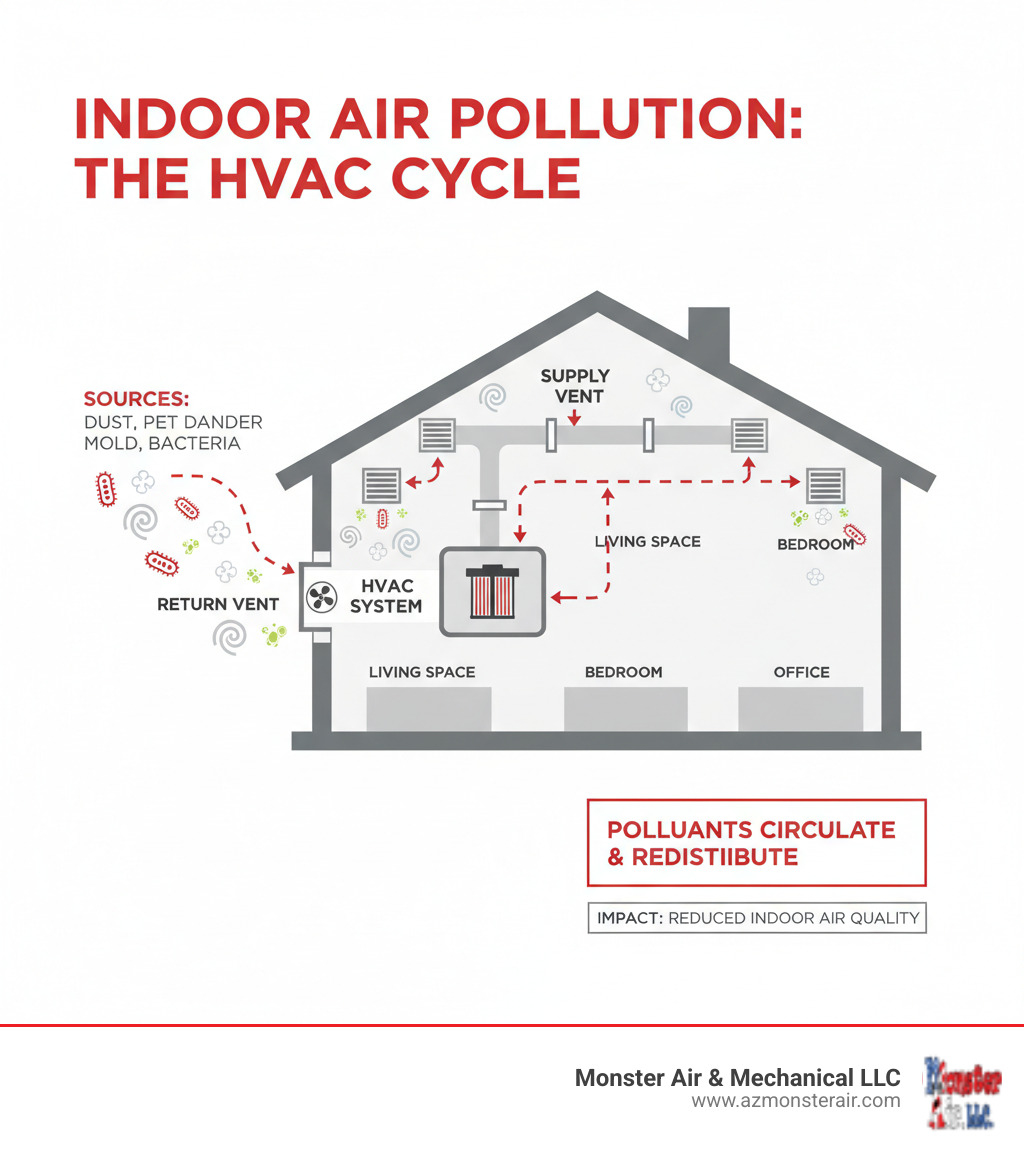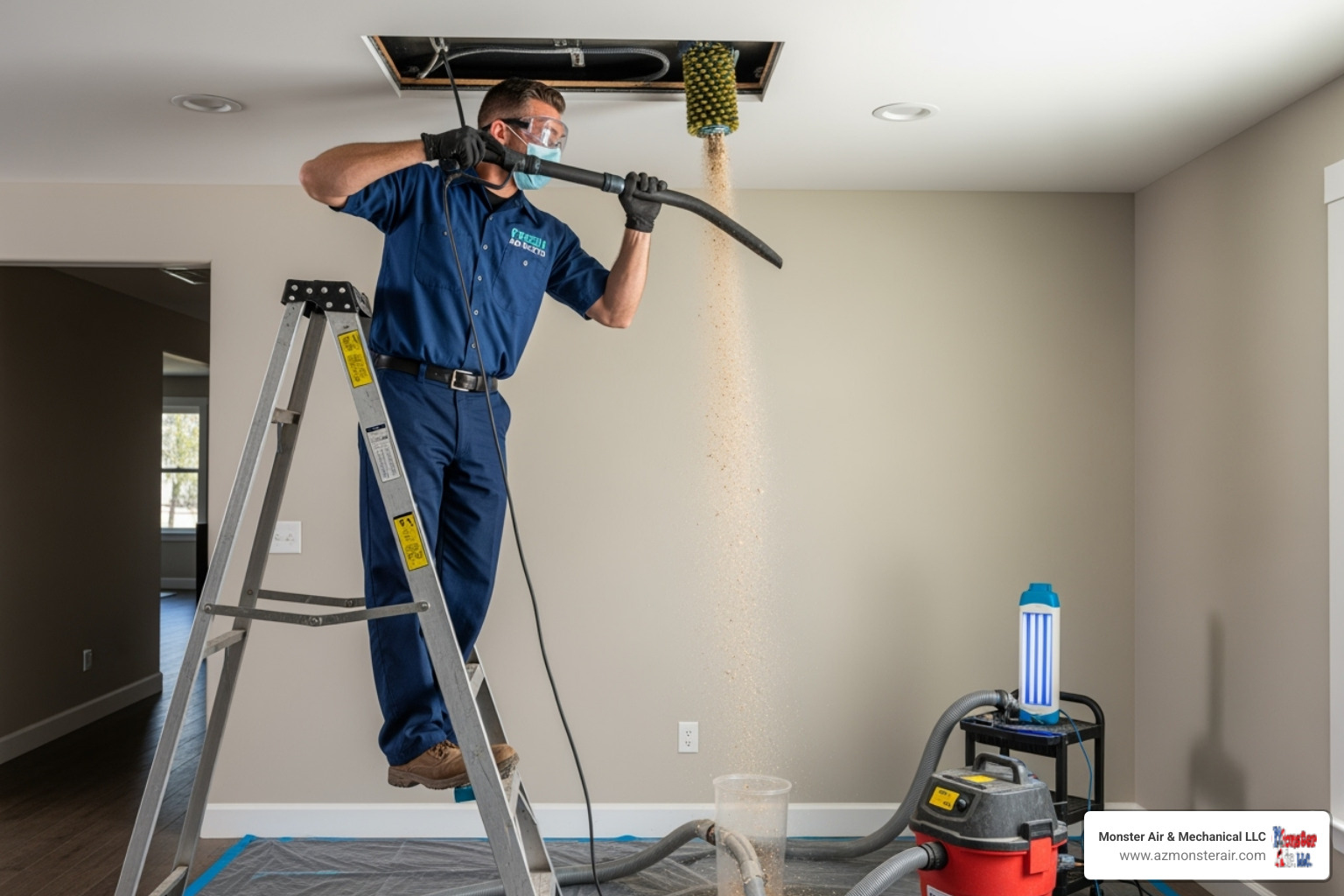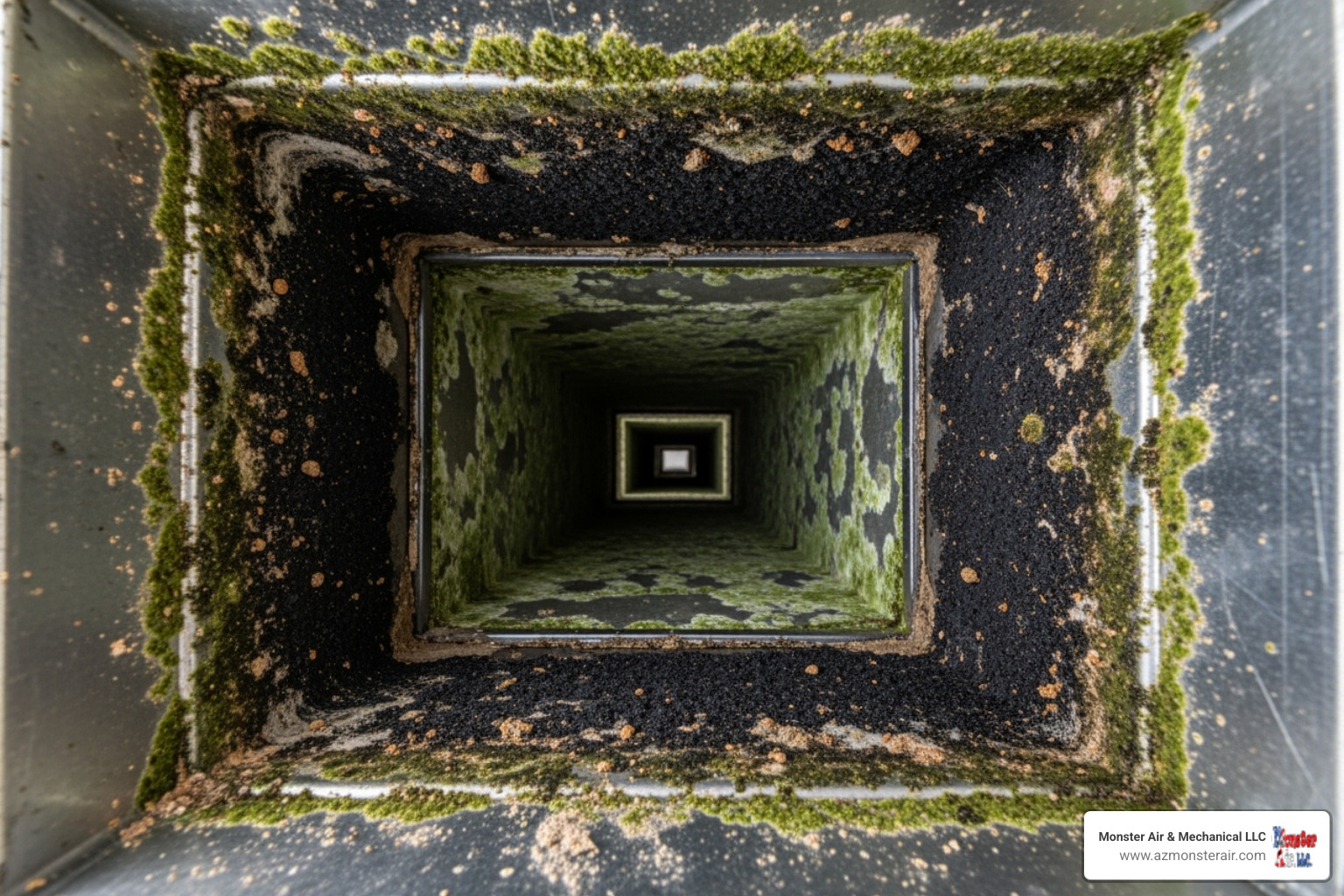Why Air Duct Cleaning and Sanitizing Matters for Your Home
Air duct cleaning and sanitizing is a service that removes dust, debris, allergens, and harmful microorganisms from your HVAC system's ductwork. While the EPA states that duct cleaning has not been conclusively shown to prevent health problems, it can improve indoor air quality when performed correctly in situations where contamination is present.
When to Consider Air Duct Cleaning and Sanitizing:
- Visible mold growth inside ducts or on HVAC components
- Pest infestation (rodents or insects) in your ductwork
- Excessive dust and debris releasing into your home from vents
- After water damage or leaks affecting your duct system
- Post-renovation with significant construction dust
- Unexplained allergy or asthma symptoms in your household
Indoor air can be two to five times more polluted than outdoor air, according to the EPA. Your HVAC system circulates air throughout your home constantly, and if your ducts are contaminated with dust, pet dander, mold spores, or bacteria, these pollutants get distributed to every room.
The truth is this: Not every home needs duct cleaning. But if you're seeing visible contamination, experiencing unexplained respiratory issues, or facing one of the situations above, professional cleaning and sanitizing can make a real difference.
The challenge? Knowing what's actually necessary versus what's just marketing hype. Many companies make unsubstantiated health claims or use "blow-and-go" tactics that do more harm than good. That's why understanding the difference between cleaning, sanitizing, and disinfecting—and knowing how to choose a reputable provider—is critical before you hire anyone to touch your HVAC system.

Cleaning vs. Sanitizing vs. Disinfecting: What's the Difference?
When you're looking into improving your home's indoor air quality, you'll often hear these three terms tossed around like they mean the same thing: cleaning, sanitizing, and disinfecting. But here's the truth—they're actually quite different from each other, and understanding those differences can save you money and help you make the right choice for your home's HVAC system.
Think of it this way: cleaning is like washing the dishes, sanitizing is like reducing germs on a kitchen counter, and disinfecting is like sterilizing medical equipment. Each process has its own purpose and level of intensity.
| Process | Purpose | Method | Outcome |
|---|---|---|---|
| Cleaning | Removes visible dirt, dust, and debris | Physical removal using vacuums, brushes, and agitation tools | Eliminates contaminants that can circulate through your home |
| Sanitizing | Reduces bacteria and germs to safer levels | Application of EPA-registered sanitizers, often through fogging | Lowers microbial counts but doesn't eliminate all microorganisms |
| Disinfecting | Kills specific viruses, bacteria, and pathogens | Application of EPA-registered disinfectants with required dwell time | Eliminates targeted harmful microorganisms |
Air duct cleaning is the foundation of any duct maintenance service. It's all about source removal—physically extracting the dust, pet dander, pollen, and other debris that's accumulated in your ductwork over time. Professional technicians use high-powered vacuums and specialized agitation tools to dislodge and remove these contaminants from your system.
When done properly, cleaning alone can make a noticeable difference in your home's air quality. After all, you're removing the stuff that's been circulating through your living spaces every time your HVAC system kicks on.
Sanitizing takes things a step further by targeting microbial contamination—the bacteria, germs, and fungi that cleaning alone might not fully address. According to EPA definitions, a sanitizer reduces (but doesn't necessarily eliminate) microorganisms to levels considered safe by public health standards.
In duct work, sanitizing typically involves applying EPA-registered products through a fogging process after the ducts have been cleaned. This is particularly useful in homes where there's been moisture issues, pet accidents in the ductwork, or concerns about bacteria growth.
Disinfecting is the most intensive level of treatment, designed to kill specific viruses, mold spores, and other pathogens. While a sanitizer reduces germs, a disinfectant actually eliminates them when used according to manufacturer instructions. This involves applying chemical solutions that must remain on surfaces for a specific "dwell time" to be effective.
Disinfecting becomes necessary in situations like mold remediation, after sewage backups affecting your HVAC system, or when you need to address specific disease-causing microorganisms. It's not something every home needs, but when you do need it, nothing else will get the job done properly.
The key takeaway? Air duct cleaning and sanitizing work together as a one-two punch. Cleaning removes the physical contaminants, while sanitizing addresses the microscopic threats. Disinfecting is reserved for more serious contamination issues where specific pathogens need to be eliminated.
Want to learn more about how these services can improve your home's air quality? Check out our Indoor Air Quality Services to see what options might be right for your situation.
Air Duct Cleaning: The Foundation
Before you can sanitize or disinfect anything, you need to start with a thorough cleaning. And we're not talking about a quick vacuum job—proper air duct cleaning means removing every bit of physical debris that's built up in your system.
This is where the real work happens. Professional technicians use high-powered vacuums that create negative pressure throughout your entire duct system, pulling loosened debris into a containment unit. At the same time, they use agitation tools—rotating brushes, air whips, and compressed air nozzles—to dislodge stubborn dust, dander, and pollen that's stuck to duct walls.
The goal is complete source removal. That means getting rid of the dust bunnies, the pet hair, the construction debris from that kitchen remodel five years ago, and all the other stuff that shouldn't be circulating through your home's air supply.
Think about it: your HVAC system is constantly pulling air through these ducts. If they're coated with dust and debris, every time your furnace or air conditioner runs, you're essentially blowing that contamination into your living spaces. Cleaning removes that source of indoor air pollution.
This foundational step is critical because you can't effectively sanitize dirty ducts. Any treatment you apply will just coat the debris rather than treating the duct surfaces themselves. It's like trying to disinfect a dirty countertop without wiping it down first—you're wasting time and product.
For more details on how this process works and what you can expect, take a look at our article on How Duct Cleaning Improves Air Quality.
Air Duct Sanitizing: Reducing Microorganisms
Once your ducts are clean, sanitizing addresses what you can't see with the naked eye: bacteria, germs, and fungi that may be living in your ductwork.
Here's what many homeowners don't realize—your ducts can harbor microscopic organisms even when they look clean. These microorganisms thrive in dark, sometimes damp environments, and your ductwork can be the perfect breeding ground if conditions are right.
Sanitizing uses EPA-registered products specifically designed to reduce these microbial populations. The most common application method is fogging, where a fine mist of sanitizer is dispersed throughout your entire duct system, reaching every nook and cranny that would be impossible to access manually.
These products are formulated to be safe for use in HVAC systems while still being effective at reducing bacteria and other microorganisms. They're not harsh chemicals that will damage your ductwork or leave harmful residues in your home's air supply.
When is sanitizing needed? Consider it if you've dealt with water damage that affected your ducts, if you've had rodents or other pests in your ductwork (even after removal and cleaning), if someone in your home has been seriously ill, or if you're noticing persistent musty odors coming from your vents.
Sanitizing is also smart for homes with family members who have compromised immune systems, severe allergies, or respiratory conditions like asthma. Reducing the microbial load in your ductwork can help create a healthier indoor environment for vulnerable individuals.
The beauty of sanitizing is that it works in conjunction with cleaning—not as a replacement for it. You get the best of both worlds: physical contaminant removal plus microbial reduction.
Air Duct Disinfecting: Eliminating Specific Threats
Disinfecting is the heavy artillery of duct treatment. While sanitizing reduces microorganisms, disinfecting is designed to kill them—specifically targeting viruses, mold spores, and other serious pathogens.
This isn't something every home needs, and honestly, it's not something you should pursue unless you have a specific reason. Disinfecting involves chemical applications that are more intensive than sanitizing products, and they require careful handling by trained professionals.
The EPA registers disinfectants separately from sanitizers because they meet stricter standards for eliminating microorganisms. These products must demonstrate that they can kill specific pathogens—including viruses and disease-causing bacteria—when used according to label directions.
When is disinfecting necessary? The most common scenario is mold remediation. If you've had confirmed mold growth in your ductwork (not just surface dust that looks dark—we're talking actual laboratory-confirmed mold), disinfecting is often part of the remediation process after the mold has been physically removed.
Other situations that might call for disinfecting include sewage backups that have contaminated your HVAC system, outbreaks of contagious illness in your home, or documented presence of specific harmful microorganisms identified through testing.
The key word here is "specific." Disinfecting targets particular threats that have been identified. It's not a routine maintenance service—it's a solution to a specific problem.
Professional application is absolutely critical. These products have required dwell times (the amount of time they must remain wet on surfaces to be effective), and they need to be applied at proper concentrations. Too little and they don't work; too much and you're wasting product and potentially creating other issues.
If you're dealing with mold concerns or other serious contamination in your HVAC system, professional assessment is the first step. A qualified technician can determine whether you actually need disinfecting or if cleaning and sanitizing will address your situation.
For more information about comprehensive duct services and indoor air quality solutions, visit our Indoor Air Quality Services page.




_11zon%20(1).webp)





